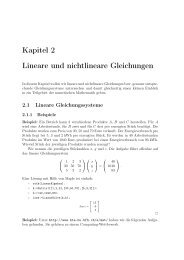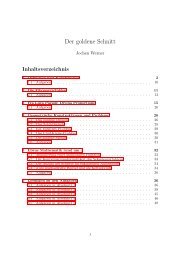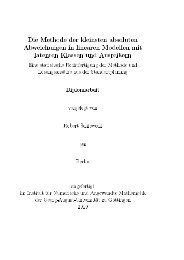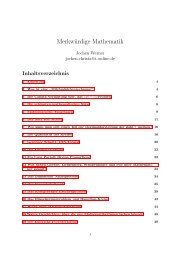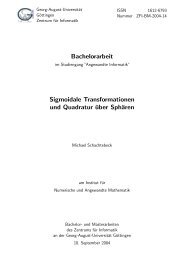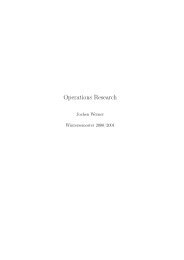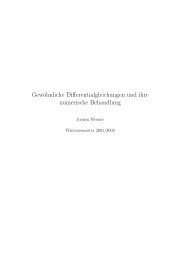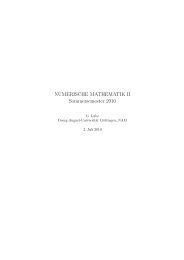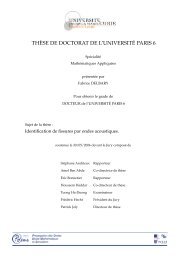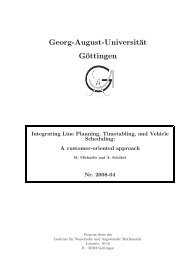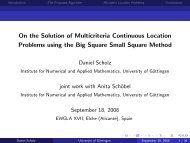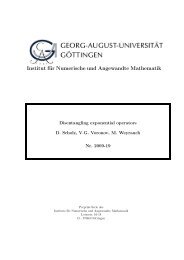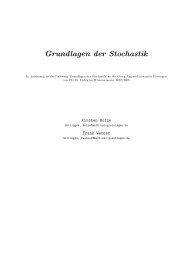BAIL 2006 Book of Abstracts - Institut für Numerische und ...
BAIL 2006 Book of Abstracts - Institut für Numerische und ...
BAIL 2006 Book of Abstracts - Institut für Numerische und ...
You also want an ePaper? Increase the reach of your titles
YUMPU automatically turns print PDFs into web optimized ePapers that Google loves.
N.V. TARASOVA: Full asymptotic analysis <strong>of</strong> the Navier-Stokes equations in the<br />
problems <strong>of</strong> gas flows over bodies with large Reynolds number<br />
✬<br />
✫<br />
the application <strong>of</strong> the Euler equations for incompressible flow outside the bo<strong>und</strong>ary layer and the<br />
classical equations <strong>of</strong> the compressible bo<strong>und</strong>ary layer near the body surface makes impossible<br />
the agreement between both equation systems.<br />
To consider the proposed problems from common positions another special dimensionless<br />
variables for gas parameters in the Navier-Stokes equations are introduced. These new variables<br />
are varied inside the studied flow area usually from 0 to 1 (in other words, they can vary to the<br />
value <strong>of</strong> the order <strong>of</strong> unit). The main idea to use such special dimensionless variables is that in<br />
this case all governing parameters that can be both small and not small are indicated explicitly<br />
as the coefficients in the equation system. Among these parameters are M 2 ∞ and ∆T/T0 (∆T is<br />
the temperature drop and T0 is the characteristic value <strong>of</strong> the temperature in the area).<br />
It should be noticed that in the hyposonic flows the gravity force can affect significantly the<br />
gas flow (in studies <strong>of</strong> free and induced convection). In term <strong>of</strong> asymptotic analysis it means<br />
that it is necessary to take account <strong>of</strong> one more parameter, for example 1/Fr (Fr is the Frud<br />
number) that can be both small and not small.<br />
The full asymptotic analysis is carried out for all mentioned situations on the base <strong>of</strong><br />
comparison <strong>of</strong> all parameters mentioned above (M 2 ∞, ∆T/T0, 1/Fr) with the standard small<br />
parameter ε in order <strong>of</strong> magnitude. As a result, the model for gas flow in both areas is formulated<br />
and an attempt to construct the procedure <strong>of</strong> the agreement <strong>of</strong> the solutions in both areas is<br />
made. It should be stressed that the equation systems derived <strong>und</strong>er the assumptions 1) - 4)<br />
differ from each other.<br />
This model constructed for the cases 2) and 3) possibly can occupy the intermediate place<br />
between two classical approaches when a gas is considered as incompressible or compressible one<br />
over the whole flow field.<br />
The equations describing hyposonic flows (M → 0) with the arbitrary values <strong>of</strong> the Reynolds<br />
number (Re), ∆T/T0 and 1/Fr were derived in [2] from the Navier-Stokes equations on the base<br />
<strong>of</strong> the asymptotic analysis with the Mach number (M) as a small parameter. In this work an<br />
attempt to compare the model constructed for cases 2) and 3) with the results obtained in [2]<br />
when considered flow with the large Reynolds number was made.<br />
References<br />
1. M. Van Dyke. 1962 In: Hypersonic Flow Research (Ed. F.R.Riddell). Academic Press.<br />
2. A.I. Zhmakin, Yu.N. Makarov. 1985 Numerical modelling <strong>of</strong> hyposonic flows <strong>of</strong> viscous gas,<br />
Dokl. AN SSSR, Mekh. Zh. i Gaza 280 (4), 827–830. [in Russian]<br />
Speaker: TARASOVA, N.V. 144 <strong>BAIL</strong> <strong>2006</strong><br />
2<br />
✩<br />
✪



